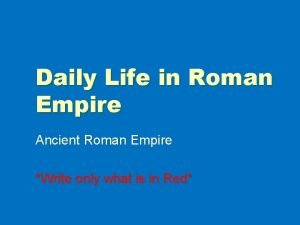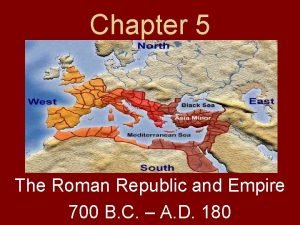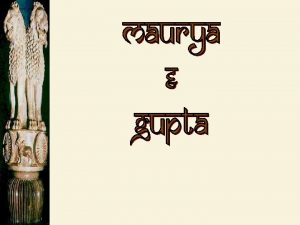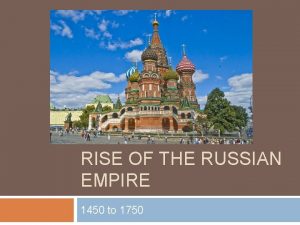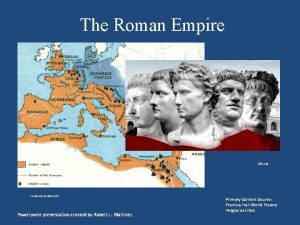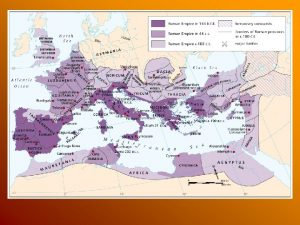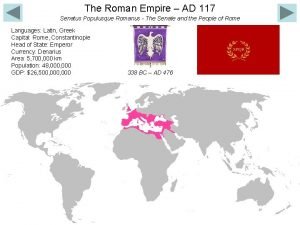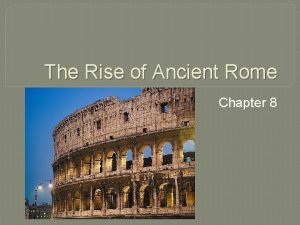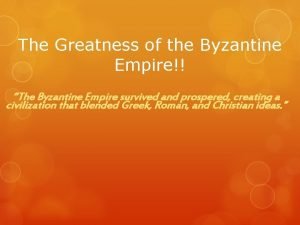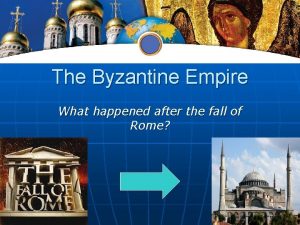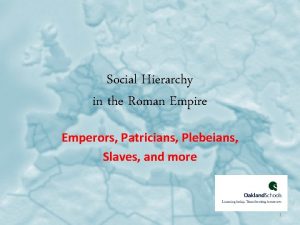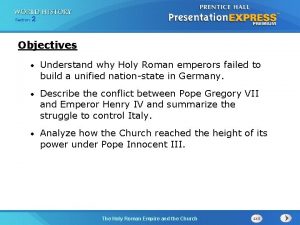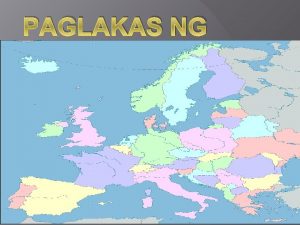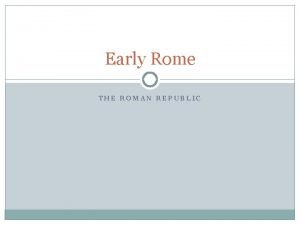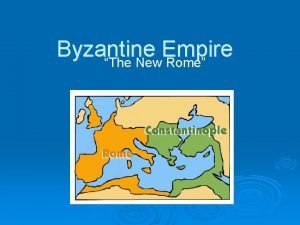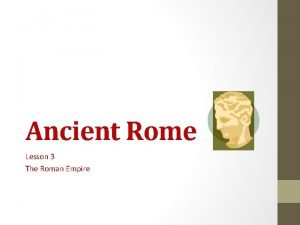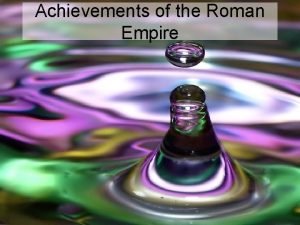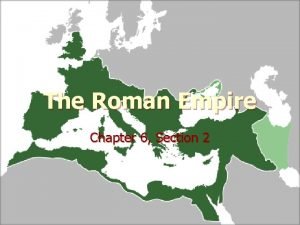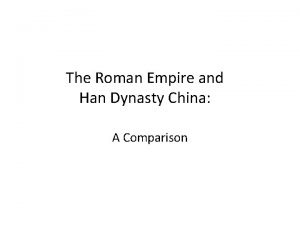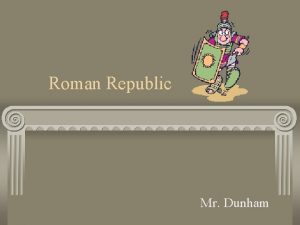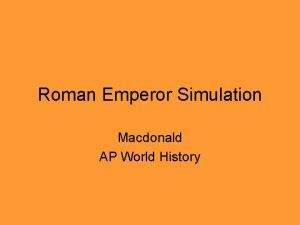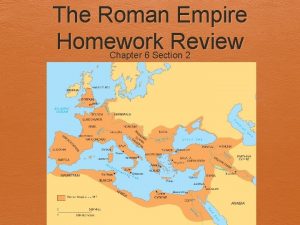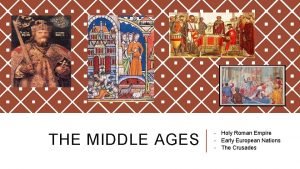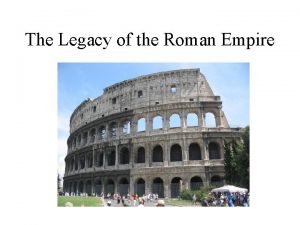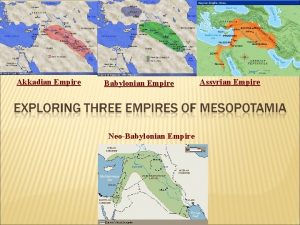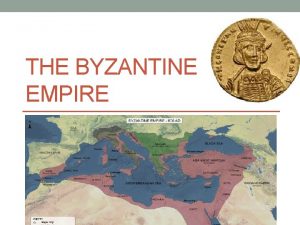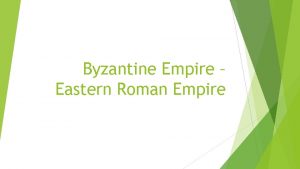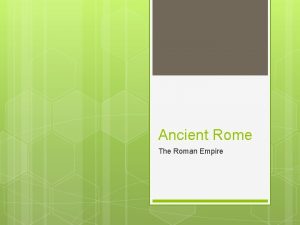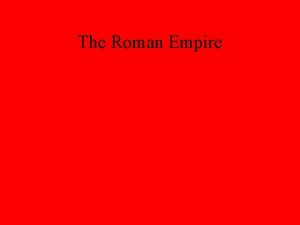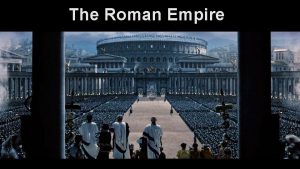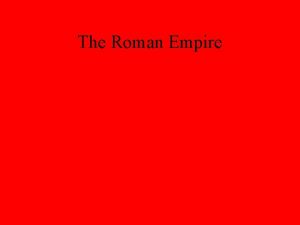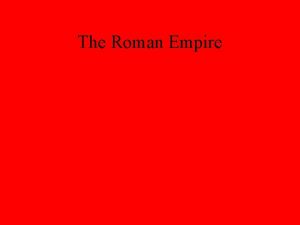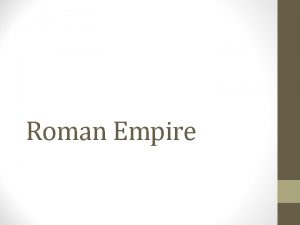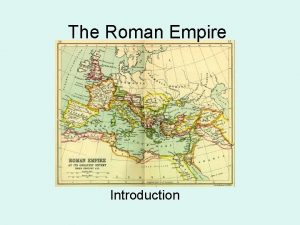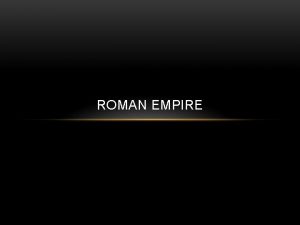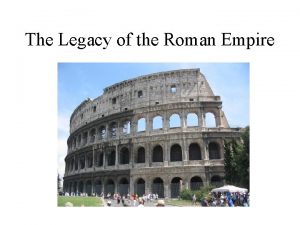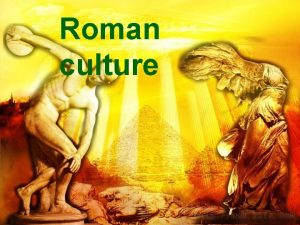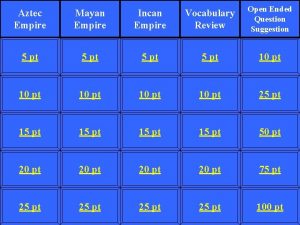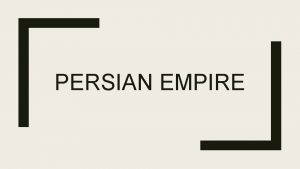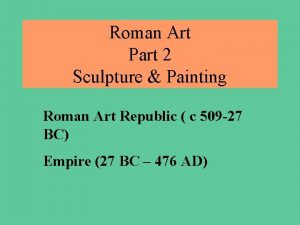THE LATE ROMAN EMPIRE ROMAN ART Late Roman
































- Slides: 32

THE LATE ROMAN EMPIRE ROMAN ART

Late Roman Empire POINTS TO REMEMBER FOR THIS SECTION: Roughly from 250 -450 CE ROMAN ART

Late Roman Empire POINTS TO REMEMBER FOR THIS SECTION: Roughly from 250 -450 CE Politically (thus economically) unstable ROMAN ART

Late Roman Empire POINTS TO REMEMBER FOR THIS SECTION: Roughly from 250 -450 CE Politically (thus economically) unstable Mostly sculptural pieces – no big structures (like Colosseum, aquaducts or Pantheon) ROMAN ART

Late Roman Empire POINTS TO REMEMBER FOR THIS SECTION: Roughly from 250 -450 CE Politically (thus economically) unstable Mostly sculptural pieces – no big structures (like Colosseum, aquaducts or Pantheon) Development of Christianity into the Empire (Edict of Milan in 313 CE legalizes Christianity… by 396 it was the OFFICIAL religion of the State) ROMAN ART

Late Empire (192 -337 CE. ) • A Civilization in Transition: At the end of the 2 nd century CE. the power of Rome was beginning to decline. • The Severans (193– 235 CE. ) – An African Rules the Empire: The African-born emperor Septimius Severus, his wife, Julia Domna, and their two sons, Caracalla and Geta • The Soldier Emperors (235– 284 CE. ): – Murder and Civil War: During the turbulent third century CE, many emperors ruled only briefly before being murdered. • Diocletian and the Tetrarchy (284– 306 CE. ) – Power Shared and Order Restored: Diocletian established the tetrarchy and adopted for himself the title of Augustus of the East. He ruled the East together with a Caesar of the East. The other two tetrarchs ruled as the Augustus and the Caesar of the West • Constantine (306– 337 CE. ) – Constantine and the Rise of Christianity: Following the defeat of Maxentius at the battle at the Milvian Bridge, Constantine believed the Christian god helped him in battle. So he ended the persecution of Christians. In 325 CE. , at the Council of Nicaea, Christianity became the official religion of the Roman Empire.

Late Roman Empire The emperor Commodus (the son of Marcus Aurelius) was probably insane. He claimed at various times to be the reincarnation of Hercules and Jupiter. He order the months of the Roman year to be named after him and changed the name of Rome to Colonia Commodiana. He was eventually strangled in his bath. The reign of Commodus marked the beginning of a period of economic and political decline. Commodus as Hercules, ca. 191 -192 AD, LATE EMPIRE ROMAN ART

Late Roman Empire When civil conflict following Commodus’s death ended, an African general named Septimius Severus was master of the Roman world. The new emperor proclaimed himself as Marcus Aurelius’s son. For this reason, he is depicted with long hair and the “trademark” beard. Painted portrait of Septimius Severus and his family 200 AD, LATE EMPIRE ROMAN The Severan family portrait is special for two reasons beyond its mere survival. The emperor’s hair is tinged with gray, suggesting that his marble portraits also may have revealed his advancing age in this way. Also noticed in the portrait, the face of the emperor’s youngest son, Geta, was erased. When Caracalla succeeded his father as emperor, he had his brother murdered and his memory damned. The painted tondo, circular format, portrait is an eloquent testimony to that damnatio memoriae and to the long arm of Roman authority. The concept of damnatio memoriae is also evident in Ancient Egypt, when Thutmose III had all rememberances of Hatshepsut destroyed after her death. ROMAN ART

• From Egypt, ca. 200 CE. Tempera (pigments in egg yolk) on wood, approx. 14" diameter • In 193 CE. an African named Septimius Severus, who was the general of the army in Upper Pannonia, became emperor with the support of the Roman army. • Septimius Severus died in England, at York, in February 211 CE. He left the Empire jointly to his two sons, Caracalla and Geta. He is said to have told them to take care of each other and the army, and never mind anything else. • Caracalla killed Geta. He even had Geta’s name and image erased from monuments all over the Empire. See the defaced portrait at right > This is the only surviving painted image of any Roman emperor!

Late Roman Empire Portrait of Caracalla, ca. 211 -217 CE. LATE EMPIRE ROMAN Typical sculpture of the ruthless emperor Caracalla. The sculptor suggested the texture of his short hair and cropped close beard. Caracalla’s brow is knotted, and he abruptly turns his head over his left shoulder, as if he suspects danger from behind. He was killed by an assassin’s dagger in the sixth year of his ruling. ROMAN ART

Late Roman Empire • Caracalla’s ruthless character was captured in his portrait images. • Caracalla fought wars throughout his reign. But he was stabbed to death by his own guards in 217 CE. in the middle of the Parthian war. The leader of the guards, Macrinus, proclaimed himself emperor. • Caracalla’s short beard & close cropped hair were created by incising the marble’s surface. • Often finely carved, his portraits look compact but convey an explosive energy. He abruptly turns his head over his left shoulder, as if he suspects danger from behind. ROMAN ART

Figure 10 -71 Battle of Romans and barbarians (Ludovisi Battle Sarcophagus), from Rome, Italy, ca. 250– 260 CE. Marble, approx. 5’ high. Museo Nazionale Romano -Palazzo Altemps, Rome. Battle of Romans and Barbarians: The writhing and highly emotive figures were spread evenly across the entire relief, with no illusion of space behind them. Notice the victorious emperor at the center. ca. 250– 260 CE. Marble, approx. 5’ high 89

Late Roman Empire Ludovisi Battle Sarcophagus Marble, ca. 250 CE. LATE EMPIRE ROMAN This sarcophagus, also known as the Great Ludovisi sarcophagus (or the Via Tiburtina Sarcophagus), is thought to be a memorial to the wars between the Ostrogoths and Imperial Romans then taking place. It was found in 1621 and named after Ludovico Ludovisi, its initial modern owner. The front of the sarcophagus shows a battle scene between Roman soldiers and Germans. The Germans have distinctive clothing, beards, and hairstyles that distinguishes them from the cleanshaven Romans. The Roman on horse back in the center-top has been identified with Hostilian, son of the emperor Decius, who died in 252 A. D. ROMAN ART

Figure 10 -71 Detail Roman general (perhaps Ostilianus, Emperor Dicius' son, died 252 AD) and his horse © 2005 Saskia Cultural Documentation, Ltd. 90

Late Roman Empire Portraits of the Four tetrarchs St. Mark’s, Venice, 305 CE LATE EMPIRE ROMAN In 293 Diocletian established a tetrarchy with himself as the Eastern ruler (Augustus of the East) and Maximian as ruler of the West. Each had a caesar, a vice-ruler, who was his heir. This political solution and attempt to retain order in the Roman Empire failed after Diocletian retired in 305. Carved in porphyry, a hard purple stone used primarily for imperial objects, these four emperors symbolize the equality of their rule. No individualized features are represented; they are dressed identically, even to their swords, and they are of equal height. Their embraces also indicate their unity. The staring eyes, squatty forms, and absract quality are characteristic of much late Roman sculpture, where symbolism is more important than realism and individuality. ROMAN ART

• Made of porphyry (purple marble). approx. 4' 3" high. Saint Mark's, Venice • Artists did not try to capture the individual appearances and personalities of the Tetrarchs, but sought instead to represent the nature of the tetrarchy itself – that is, to portray four equal partners in power. • All are identically clad & each embraces the other as a display of concordance. • Figures have large cubical heads on squat bodies & Faces are emotionless. • Individuality, personality, & idealism in portraiture have given way to iconography. Portrait of the Four Tetrarchs

Late Roman Empire Portraits of the Four tetrarchs St. Mark’s, Venice, 305 CE LATE EMPIRE ROMAN ART

Late Roman Empire Arch of Constantine Rome, Italy 312 -315 CE LATE EMPIRE ROMAN Constantine’s decisive victory over Maximentius resulted in a a great triplepassageway arch in the shadow of the Colosseum. The arch was the largest erected in Rome since the end of the Severan dynasty nearly a century before. There is great sculptural decoration, which was taken from earlier monuments of Trajan, Hadrian, and Marcus Aurelius. Sculptors re-cut the heads of the earlier emperors with the features of the new ruler in honor of Constantine. They also added labels to the old reliefs that were references to the downfall of Maxentius and the end of civil war. The reuse of statues and reliefs by Constantinian artists has been seen as a decline in creativity and technical skill in the waning years of the pagan Roman Empire. The arch is a great triplepassageway in the shadow of the Colosseum. It commemorates the defeat of Maxentius on the Milvian Bridge. ROMAN ART

The shallow reliefs on the Arch of Constantine show poorly modeled undistinguished figures that are squat in proportion. The Arch of Constantine The figures have mechanical gestures and many repeat the same stance as others. Arch of Constantine – Sm. ART History video Re-fashioned reliefs, taken from earlier monuments were utilized, probably because of the poor conditions of sculpture studios at the time. The re-purposing of older art works also shows that Constantine saw himself as the restorer of Roman glory.

Late Roman Empire Arch of Constantine Rome, Italy 312 -315 CE LATE EMPIRE ROMAN Reuse of statues and reliefs by Constantinian artists shows evidence of decline in creativity and technical skill of the waning years of the pagan Roman Empire. Reused sculptures, however, were carefully selected to associate Constantine with the good emperors of the 2 nd century, underscored by reliefs above the lateral passageways, one of which depicting Constantine on the speaker’s platform in the Roman Forum flanked by statues of Hadrian and Marcus Aurelius. ROMAN ART

Late Roman Empire Arch of Constantine Rome, Italy 312 -315 CE. ROMAN ART

95

• This frieze Frieze, was Arch made of Constantine, specifically for early the 4 tharch century (not taken CE. from elsewhere). • It shows Constantine addressing the Senate; no sense of movement, no spatial depth, no foreshortening, shallow doll-like figures, no contrapposto. • The composition is abstracted on purpose, it is symmetrical to show the importance of the emperor in the center. The only figure to be shown full -frontal is Constantine (his head has been knocked off). The design points toward Christian (Medieval) art.

The Distribution of Largess • Detail of north frieze of the Arch of Constantine, Rome, Italy, 312– 315 CE. Marble, approx. 3' 4" high • Sculptors refashioned reliefs from previous emperors’ monuments. They also added labels like Fundador Quietus (bringer of peace), and Liberator Urbis (liberator of the city). • In this frieze Constantine is shown giving largess to the citizens on either side of him. The figures are squat & move mechanically. • The relief is shallow and the forms are not fully modeled. It is a crowd rather than a composed group of individuals (as was seen on the Ara Pacis).

The Distribution of Largess Frieze, Arch of Constantine, early 4 th century CE. How does the principle of rhythm play a part in these two examples? Procession of the Imperial Family Ara Pacis, Rome, Italy ca. 13 -9 BCE.

Late Roman Empire Portrait of Constantine, from the Basilica Nova Rome, Italy, 315 -330 CE LATE EMPIRE ROMAN Built after Constantine’s victory over Maxentius, broke with tetrarchic tradition and the style of soldier emperors and resuscitated the Augustan image of the eternally youthful head of state. 8 1/2 foot tall head that was part of a 30 foot tall statue of the emperor, made of a brick core, a wooden torso laced with bronze, and head and limbs of marble. Emperor once held an orb in his left hand that symbolized global power Nervous glance of 3 rd century portraits is gone, now with frontal mask and enormous eyes ROMAN ART

Portrait Head of Constantine • This is the most impressive of Constantine’s preserved marble portraits. • The head is 8. 5 feet high. • The entire statue was a colossal 30 feet high. It had a brick core, a wooden torso covered with bronze and heads & limbs of marble. • The emperor held a globe and a Christian cross. • It is similar to the massive statue of Ramses II, in terms of size and the conveyance of power. Colossus of Constantine – Sm. ART History video

Figure 10 -79 Reconstruction drawing of the Basilica Nova (Basilica of Constantine), Rome, Italy, ca. 306– 312 CE. Rome, Italy, ca. 306 -312 CE. The original structure was 300’ long & 115’ wide 100 with walls 20’ thick. Notice the clerestory windows.

• Largest roofed interior in all of Rome • Basilicas with long halls served civic purposes, and were a standard feature of every Roman town. They often held the courts. • Nave – the center tract • Clerestory – the upper part of the nave, pierced with large windows to let in light Reconstruction drawing of the Basilica of Constantine • The raised roof of the clerestory was possible because the groined vaults helped center the weight on the four corners.

Basilica of Constantine, Rome, 310 -20 CE

31

Late Roman Empire Coming up… The new church based on the Roman basilica! ROMAN ART
 Life in the roman empire
Life in the roman empire High empire roman art
High empire roman art Cursus honorum
Cursus honorum Roman republic vs roman empire
Roman republic vs roman empire American empire vs british empire
American empire vs british empire Venn diagram of mauryan and gupta empires
Venn diagram of mauryan and gupta empires Russian empire art and architecture 1450 to 1750
Russian empire art and architecture 1450 to 1750 Pbs roman empire
Pbs roman empire Roman empire begins
Roman empire begins French empire
French empire Rome chapter 8
Rome chapter 8 What event marked the fall of rome in 476 c.e.?
What event marked the fall of rome in 476 c.e.? How was byzantium a continuation of the roman empire?
How was byzantium a continuation of the roman empire? Roman empire at its height
Roman empire at its height Eastern and western roman empire map
Eastern and western roman empire map Map of the byzantine empire under justinian
Map of the byzantine empire under justinian Hierarchy in an empire
Hierarchy in an empire The holy roman empire and the church section 2
The holy roman empire and the church section 2 The holy roman empire and the church section 2
The holy roman empire and the church section 2 Ano ano ang dalawang uri ng bourgeoisie
Ano ano ang dalawang uri ng bourgeoisie Glory of the roman empire
Glory of the roman empire Split of roman empire
Split of roman empire Lesson 3 the early roman empire
Lesson 3 the early roman empire Roman empire achievements
Roman empire achievements The roman empire chapter 6 section 2
The roman empire chapter 6 section 2 Roman china
Roman china Roman empire gif
Roman empire gif Roman emperor.simulator
Roman emperor.simulator Importance of secretary
Importance of secretary Golden age of the roman empire
Golden age of the roman empire Calvinism map
Calvinism map Feudal system definition
Feudal system definition What was the legacy of the roman empire
What was the legacy of the roman empire
